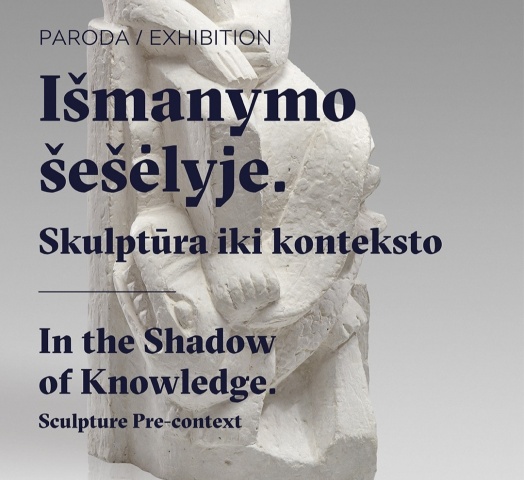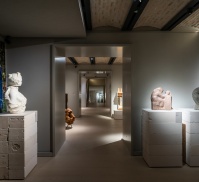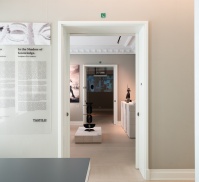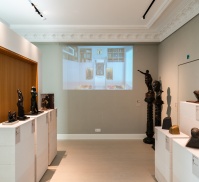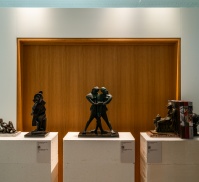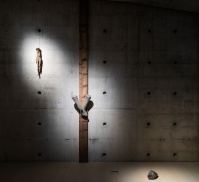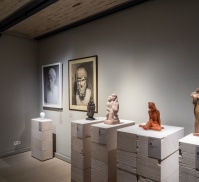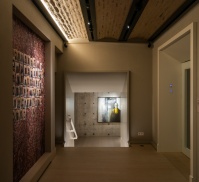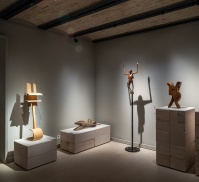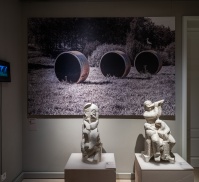Current exhibition
In the Shadow of Knowledge. Sculpture Pre-context
“We also hold what resides in the shadow of knowledge,” remarked Vladas Urbanavičius, one of Lithuania’s most renowned sculptors, in conversation with the art critic Alfonsas Andriuškevičius. This idea defines the concept of the exhibition, which presents sculpture as a direct, sensory experience. Sculpture in the shadow of knowledge invites viewers to encounter sculptural objects before contextualizing their themes or meanings. Here, the emphasis is on the intrinsic properties of sculpture – its spatial presence, materiality, and emotional impact – elements we perceive immediately, before engaging in rational analysis and starting to “read” the work like a book. The exhibition unfolds in three sections: space, material, and dream. It features works from the TARTLE collection, spanning the 19th to the 21st centuries, with a strong focus on classical and modernist Lithuanian sculpture. Complementing these pieces are contemporary sculptures from artists’ private collections, which challenge tradition and invite new ways of seeing – offering moments of surprise and discovery.
Space. Space is one of the most fundamental aspects of sculpture. This exhibition explores both public and private space, showcasing models of sculptures designed for public settings alongside small-scale works intended for more intimate environments.
Material. Sculpture is an art of materials. Material defines a sculpture’s authenticity; it is, in a sense, its mother. This exhibition highlights the importance of materiality through key sculptural mediums such as stone and wood, alongside what could be called “liberated assistants” – gypsum, chamotte, terracotta, and plastic.
Dream. In this exhibition, modernist sculpture enters into dialogue with contemporary works, where both space and material are in flux. The scale and proportions of objects shift, as does their relationship with the viewer, and familiar materials transform. Here, known rules no longer apply – we enter a realm of premonitions, emotion, and experience, where rational knowledge gives way to shadow, subconsciousness, and dream.
In the Shadow of Knowledge invites visitors to approach sculpture intuitively, discovering what might otherwise go unnoticed. Featuring over 70 works, the exhibition brings together some of Lithuania’s most celebrated sculptors from different eras – Mark Antokolsky, Jacques Lipchitz, Petras Rimša, Juozas Mikėnas, Antanas Mončys, Ksenija Jaroševaitė, Vladas Urbanavičius, and Mindaugas Navakas, Vytautas Šerys, Šarūnas Šimulynas – alongside contemporary artists such as Arūnas Gudaitis, Andrius Erminas, Nerijus Erminas, Matas Janušonis, Mindaugas Junčys, Tauras Kensminas, Eglė Pilkauskaitė, Mykolas Sauka, Marija Šnipaitė.
Curator
Doc. dr. Jurgita Ludavičienė
Architects
Doc. Aušra Siaurusaitytė Nekrošienė, Agnė Makariūnaitė
Graphic designer
Daiva Sakalauskienė

In the Shadow of Knowledge. Sculpture Pre-context
“We also hold what resides in the shadow of knowledge,” remarked Vladas Urbanavičius, one of Lithuania’s most renowned sculptors, in conversation with the art critic Alfonsas Andriuškevičius. This idea defines the concept of the exhibition, which presents sculpture as a direct, sensory experience. Sculpture in the shadow of knowledge invites viewers to encounter sculptural objects before contextualizing their themes or meanings. Here, the emphasis is on the intrinsic properties of sculpture – its spatial presence, materiality, and emotional impact – elements we perceive immediately, before engaging in rational analysis and starting to “read” the work like a book. The exhibition unfolds in three sections: space, material, and dream. It features works from the TARTLE collection, spanning the 19th to the 21st centuries, with a strong focus on classical and modernist Lithuanian sculpture. Complementing these pieces are contemporary sculptures from artists’ private collections, which challenge tradition and invite new ways of seeing – offering moments of surprise and discovery.
Space. Space is one of the most fundamental aspects of sculpture. This exhibition explores both public and private space, showcasing models of sculptures designed for public settings alongside small-scale works intended for more intimate environments.
Material. Sculpture is an art of materials. Material defines a sculpture’s authenticity; it is, in a sense, its mother. This exhibition highlights the importance of materiality through key sculptural mediums such as stone and wood, alongside what could be called “liberated assistants” – gypsum, chamotte, terracotta, and plastic.
Dream. In this exhibition, modernist sculpture enters into dialogue with contemporary works, where both space and material are in flux. The scale and proportions of objects shift, as does their relationship with the viewer, and familiar materials transform. Here, known rules no longer apply – we enter a realm of premonitions, emotion, and experience, where rational knowledge gives way to shadow, subconsciousness, and dream.
In the Shadow of Knowledge invites visitors to approach sculpture intuitively, discovering what might otherwise go unnoticed. Featuring over 70 works, the exhibition brings together some of Lithuania’s most celebrated sculptors from different eras – Mark Antokolsky, Jacques Lipchitz, Petras Rimša, Juozas Mikėnas, Antanas Mončys, Ksenija Jaroševaitė, Vladas Urbanavičius, and Mindaugas Navakas, Vytautas Šerys, Šarūnas Šimulynas – alongside contemporary artists such as Arūnas Gudaitis, Andrius Erminas, Nerijus Erminas, Matas Janušonis, Mindaugas Junčys, Tauras Kensminas, Eglė Pilkauskaitė, Mykolas Sauka, Marija Šnipaitė.
Curator
Doc. dr. Jurgita Ludavičienė
Architects
Doc. Aušra Siaurusaitytė Nekrošienė, Agnė Makariūnaitė
Graphic designer
Daiva Sakalauskienė






